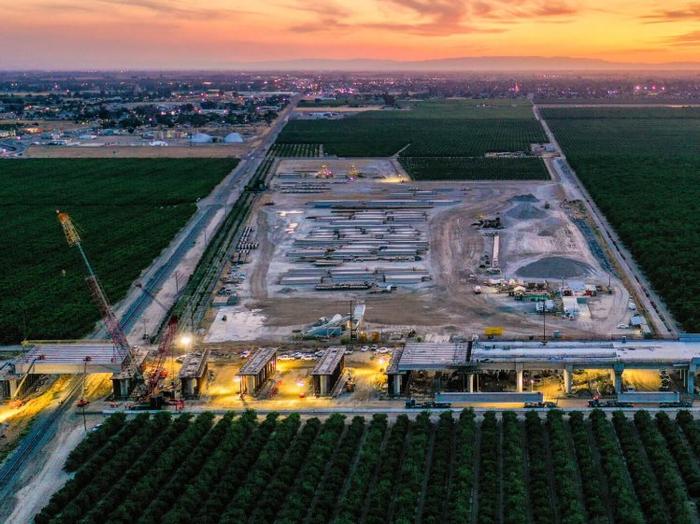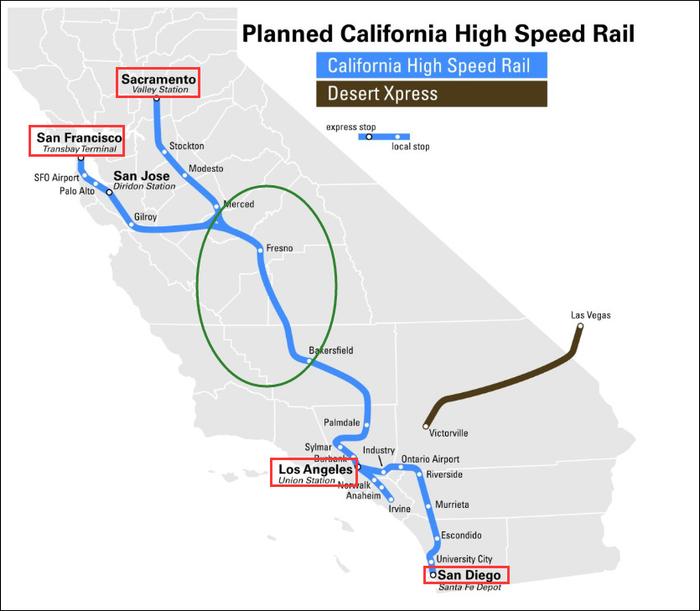

【Report by OanChen, Observation Network】
Governor Newsom of California vows to fight against the “illegal” action of the Trump administration in terminating federal funding for the California High-Speed Rail project.
According to Reuters, on July 17th local time, the California High-Speed Rail Authority filed a lawsuit in Los Angeles’s U.S. District Court against Trump’s decision, challenging it as an abuse of power characterized by “arbitrariness and caprice.” The government agency also pointed out that the investment in high-speed rail by the U.S. government is minimal compared to other countries, especially China.
On the same day, Newsom announced that the termination of funding by the Trump administration was “motivated by political reasons,” and the California High-Speed Rail Authority has initiated legal proceedings.
“Trump’s termination of federal funding for California’s high-speed rail project carries political implications, serving as another political stunt punishing California,” Newsom stated in a declaration. “In fact, this is a brutal attack on the Central Valley, endangering real jobs and livelihoods. We are suing to prevent Trump from destroying America’s only ongoing high-speed rail project.”
According to Newsom, Trump’s attacks on the California high-speed rail project were “personally hostile,” not based on actual circumstances. He mentioned that while the Trump administration terminated funding due to severe delays, the project had already entered the track laying phase, actively constructing within about 275 kilometers, having completed over 50 major railway facilities including bridges, viaducts, and elevated structures, and completing more than 97 kilometers of guideway.
Newsom stated that construction has made significant progress, “anticipating passenger services will be provided between 2030 and 2033.”
In January this year, Newsom welcomed President Trump at the airport to inspect the fire situation.
Ian Jodrell, CEO of the California High-Speed Rail Authority, said that the Trump administration’s cancellation of federal railway funding “has no reason, is erroneous, and illegal.” He insisted that the rail authority had fulfilled all obligations, and the project had created approximately 1.
550,000 job positions.
In response to issues raised by the Federal Railroad Administration regarding “failure to meet deadlines, insufficient budgets, and suspicious passenger traffic forecasts,” the California High Speed Rail Authority contended that these conclusions were “misleading” and failed to reflect “the substantial progress California has made in high-speed rail.”
The California High Speed Rail Authority also emphasized that compared to other modes of transportation, the investment by the U.S. government in high-speed rail is negligible; when compared to countries including China, the U.S. government’s investment is also significantly less. The agency mentioned that China launched its first high-speed rail service in 2008, subsequently investing $1.4 trillion to build a nearly 28,000-mile high-speed rail network.
According to data from the State Railway Group, currently, China’s high-speed rail operational mileage reaches 48,000 kilometers, accounting for over 70% of the world’s total high-speed rail mileage and covering 97% of cities with a population of over 500,000.
Earlier on the 17th, U.S. Transportation Secretary Sean Duffy expressed his confidence that the Trump administration would overcome any challenges to canceling the appropriations. He vowed, “We will end this project.”
Following the lawsuit in California, Duffy’s spokesperson responded, “Newson’s plan is naturally a waste of taxpayer money to defend this mess.” The spokesperson called out, “Then we’ll see it in court, Gavin (Newson).”
As one of the most challenging issues in the United States’ infrastructure sector, the history of the California high-speed rail project dates back to 2008.
The U.S. government has long been planning a high-speed rail project connecting two major cities in California: San Francisco and Los Angeles, stretching approximately 800 miles (about 1287 kilometers) with a maximum design speed of 350 miles per hour (220 miles per hour). The project initially planned to connect Los Angeles and San Francisco, with an estimated cost of $33 billion at its initial stage, now soaring to $128 billion.
In 2008, the project officially commenced under then-California Governor Arnold Schwarzenegger, with California voters approving the use of nearly $10 billion in bond proceeds as construction funds that year. In 2015, the first phase of the project began.
However, in February 2019, Newson announced that due to the project’s cost escalating to $77.3 billion and concerns over schedule delays and management, the high-speed rail project would be shortened to a 171-mile (approximately 275 kilometers) stretch between Merced and Beverly Hills in the Central Valley.
Today, the cost of just this section alone has reached $35 billion, exceeding the initial budget for the entire project and leaving a $7 billion funding gap.
A schematic diagram of the California High-Speed Rail Project. Note: The red box contains the original planned connection to several major cities, while the green circle represents the remaining segment after Newson reduced the project.
Trump has long been dissatisfied with the California High-Speed Rail Project. Reports indicate that during his first term in 2019, Trump attempted to revoke $929 million in federal funding, which was challenged by the state government, leading to a settlement in June 2021 under the Biden administration, restoring all funds.
In February this year, the U.S. Department of Transportation initiated compliance reviews for funding related to the California High-Speed Rail Project. On May 6th, Trump stated at the White House that his administration would not pay for the high-speed rail plan between Los Angeles and San Francisco, citing cost overruns. He said, “The government will not foot the bill.”
At that time, Newson’s spokesperson responded by playing the “China card”. He claimed that “five main buildings have been completed, and abandoning the project when we enter the track laying phase would be reckless—not only would it waste hundreds of millions already invested, but it would also hand over this generation’s infrastructure advantage to China, allowing those forces suppressing jobs to do so.”
”
In June of this year, Duffy criticized the California High-Speed Rail Authority in a statement for spending nearly $7 billion in taxpayer funds over the past 15 years without laying even a foot of track.
On July 16th, local time, U.S. Transportation Secretary Sean Duffy announced the withdrawal of $4 billion from the project. On the same day, Trump wrote on social media that he would “liberate American citizens from the disasterous and severely overbudgeted ‘towards nothing’ high-speed rail project funded by Newson.” He stated, “Thanks to Duffy, there will be no more federal funds spent on this Newson scam.”
Later that evening, California Governor Gavin Newsom issued a statement responding to the decision, calling it “illegal” and vowing to retaliate. He also mentioned China, claiming that Trump’s move was “wanting to hand over the future to China,” and said California “will not let him succeed.”
According to Reuters, despite the California government repeatedly playing the “China card,” the debate between Newsom and Trump over the California high-speed rail project is related to the partisan struggle in the United States. The report noted that Trump’s termination of federal funding marks the latest confrontation between the Republican president and the Democratic governor widely seen as a favorite for the 2028 Democratic presidential nomination.